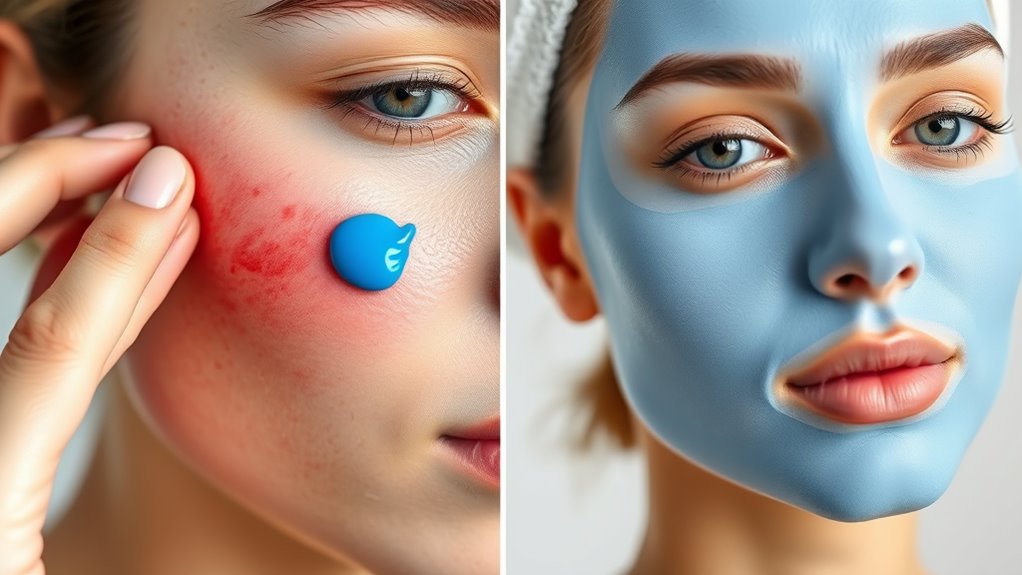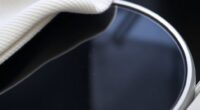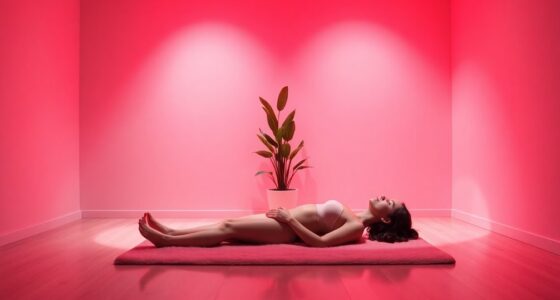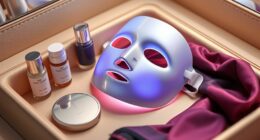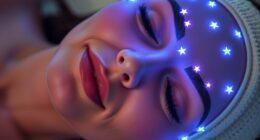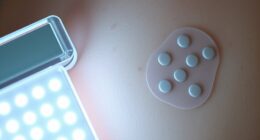If you’re choosing between blue light spot treatments and full-face sessions, consider your skin concerns and goals. Spot treatments focus energy on specific blemishes, offering quick results for isolated issues, while full-face sessions treat broader skin problems like uneven tone or acne. Spot treatments are more convenient and quicker, but full-face options promote overall clarity and texture over time. Want to find out which approach suits your skincare routine? Keep exploring to learn more.
Key Takeaways
- Blue light spot treatments target specific blemishes by killing bacteria, while full-face sessions address broader skin issues like uneven tone.
- Spot treatments with blue light offer quicker results for isolated spots; full-face sessions provide comprehensive improvement across the entire face.
- Blue light spot therapy is more convenient and time-efficient for targeted blemishes, whereas full-face treatments take longer but treat the entire skin surface.
- Spot treatments may require fewer sessions and lower costs, ideal for stubborn spots; full-face sessions may need more for overall skin health.
- Both methods benefit from multiple sessions and regular maintenance, with choice depending on individual skin concerns and treatment goals.
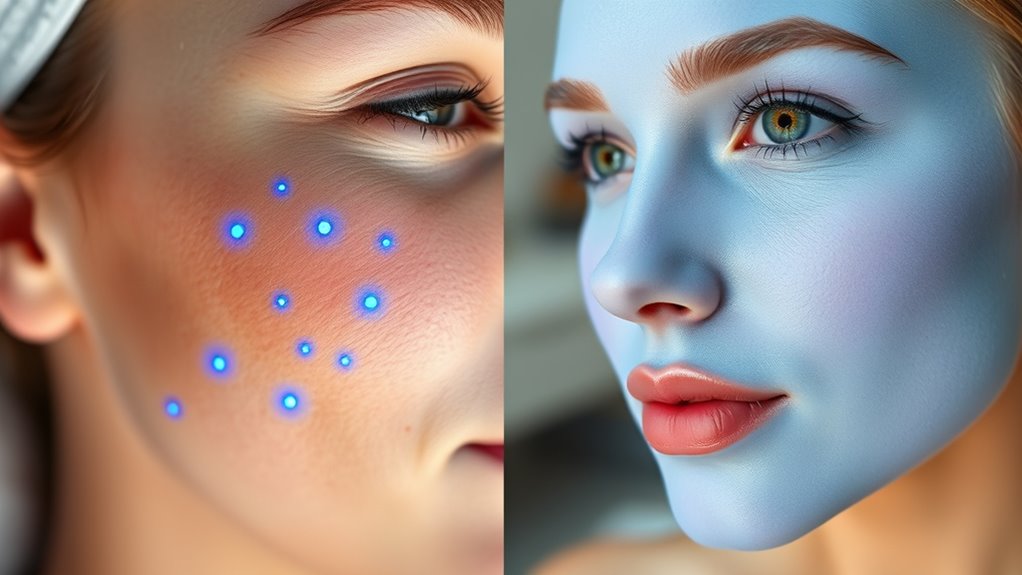
When deciding between spot-treating with blue light or opting for full-face sessions, it’s important to understand how each approach targets skin concerns. Spot treatments focus directly on specific blemishes, pimples, or acne scars, delivering targeted energy to eliminate bacteria and reduce inflammation. This precision makes it an appealing choice if you have isolated breakouts or want to address problem spots without affecting the surrounding skin. You can treat individual areas as needed, which often results in faster visible improvements on targeted spots. Plus, it minimizes exposure to unaffected areas, reducing the risk of unnecessary irritation or dryness. Incorporating the mindset principles of consistency and patience can enhance results over time. Full-face sessions, on the other hand, treat your entire face at once. This approach is designed to address broader skin issues like overall acne, clogged pores, or uneven skin tone. When you opt for full-face blue light therapy, the device covers a larger surface area, providing a thorough treatment that helps improve skin texture and clarity over time. It’s especially effective if your skin concerns are widespread rather than isolated. Regular full-face treatments can lead to more uniform results, as they target multiple areas simultaneously, promoting balanced healing and reducing the likelihood of new breakouts in untreated zones. Spot treatments tend to be quicker and more convenient if you only have a few blemishes. You can focus your efforts on problem areas, making it easier to fit into a busy schedule. However, they require careful targeting to ensure you’re hitting the right spots each time. Full-face sessions may take longer but can be more efficient overall if your skin issues are extensive. Instead of multiple spot treatments, you get a thorough session that covers your whole face, which can be more consistent in delivering results. This method also encourages a routine that promotes overall skin health rather than just reacting to individual problems. Cost can influence your choice as well. Spot treatments often require fewer sessions, which can save you money if you only need to target specific blemishes. Conversely, full-face treatments might involve more sessions but could be worth it if you’re seeking a more uniform and long-term solution. Keep in mind that both approaches generally require multiple treatments for ideal results, and regular maintenance can help sustain improvements. Ultimately, your decision depends on your skin’s specific needs, your lifestyle, and your goals. If you want quick fixes for stubborn spots, spot-treating might be best. But if your skin shows signs of widespread issues, full-face sessions could deliver more consistent results. Either way, understanding how each method works helps you make an informed choice that aligns with your skincare routine and desired outcomes.
Frequently Asked Questions
How Long Does Each Treatment Session Typically Last?
A spot-treatment session usually lasts about 15-30 minutes, focusing on specific problem areas. Full-face sessions tend to take longer, typically around 30-60 minutes, since they cover your entire face. The exact time depends on your skin type, the treatment area’s size, and the technician’s speed. You should plan accordingly and discuss your needs with your provider to get a clear estimate before starting.
Are There Any Side Effects Specific to Blue Light Therapy?
You might wonder if blue light therapy has side effects. While generally safe, it can cause temporary redness, dryness, or mild irritation in some cases. Rarely, you could experience eye strain or discomfort if protective eyewear isn’t used properly. But these effects usually fade quickly. Stay cautious, follow your practitioner’s advice, and report any unusual feelings immediately—you might just prevent a more serious reaction.
Can Spot Treatments Prevent the Need for Full-Face Sessions?
Yes, spot treatments can reduce the need for full-face sessions. By targeting specific areas with blue light therapy, you focus on problem spots, which may lessen overall treatment time and frequency. However, it depends on your skin’s condition and goals. You should consult with a dermatologist to determine if spot treatments are enough or if full-face sessions are necessary for thorough skin improvement.
How Many Sessions Are Usually Needed for Visible Results?
Typically, you’ll see visible results after 3 to 6 sessions, depending on your skin type and the condition being treated. Consistency is key, so follow your provider’s recommended schedule. Some individuals notice improvements sooner, while others may need more sessions for ideal results. Keep in mind that maintenance treatments might be necessary to sustain those results over time.
Is There a Recommended Skincare Routine Post-Treatment?
After your treatment, you should follow a gentle skincare routine. Use a mild cleanser, avoid harsh scrubs, and keep your skin moisturized with a non-comedogenic moisturizer. Apply sunscreen daily to protect your skin from UV damage. Avoid picking or scratching the treated area, and stay away from heavy makeup for a few days. Drinking plenty of water and avoiding excessive sun exposure will also help your skin recover faster.
Conclusion
Now that you’ve seen the differences, imagine the moment you step into your next session—will you focus on targeting those stubborn spots with blue treatment, or embrace the full-face approach? The choice could shape your skin’s future in unexpected ways. Are you ready to see what’s possible? Stay tuned—what comes next might just change everything you thought you knew about skincare. The decision is yours, but the best results are waiting to be uncovered.
